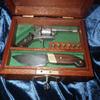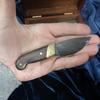Art Knives
These are knives which are not intended for actual use. They include letter openers, display pieces, fighters and bowies (although a small bowie could easily be used as a camp or hunting knife). They are made to the same exacting standards as my working knives and are every bit as tough and sharp. They include either some sort of display stand or a hand-sewn, double-stitched cow hide sheath.
Nordic "As Forged" Fighter
The finish on this knife is left rough, as-forged to show off the texture of the steel as it emerges from the fire. It has a wrought iron guard and pommel. The grip incorporates black marble, steel, leather, charred fir, and wild hazelnut. Wrought iron and hazelnut display stand. $250
Bowies
The bowie knife is named after James Bowie, a 19th century American army officer who is said to have commissioned this design. It's clipped point had a "false edge" a portion of the spine which was sharpened, like a sabre blade. He is said to have killed three men in a fight, one of them armed with a rifle. The bowie was the standard companion to the cowboy of the old West , together with his "six-shooter". It is a popular style of knife for many reasons.
Made from a variety of steels, mostly 5160 for its tough quality. $175 to $300
Letter Opener
Made exactly like a knife, but not as sharp. File work embellishment on the spine, Alabaster and steel spacers, Indian Rosewood grip. Walnut presentation box. $200
Scalpel
These art knives are a loose interpretation of an ancient surgeon's tool. They are made of stainless steel, cocobolo / alo wood, bronze, bone and an alabaster stone set into the pommel. it is a cross between an ancient Roman and medieval scalpel, adapted to modern times, as the original would have been made of bronze or iron and not stainless steel. Purely a display piece, and not intended for use.
$250
19th Century Push Dagger
The push dagger, or Gimlet Knife (Faustmesser in German) was a popular weapon with "Gentlemen Of Ill Repute", such as gamblers, pimps and robbers. Easily hidden up a coat sleeve, or in a boot, they were so common, and so often used in fights that many cities had ordnances prohibiting the possession of these. This particular piece is a replica companion knife to the authentic pinfire revolver pictured here, probably from the 1850's to 1870's. The knife has been artificially aged to resemble an antique. Brazilian Blackwood grip with a steel butt plate and W-1 steel blade. It is not currently for sale, as pushdaggers are still considered prohibited in some places.
Miniature Companion Knife
5 3/8 in long by 1 1/4 in wide, this damascus blade is a miniature companion to the 19th century, 5mm pinfire revolver. 'Can-welded" damascus steel made from W1 and 1095 with a little nickel mixed in for contrast. Brass bolsters and pins, with cocobolo scales. The display box is made of Sapele, an exotic hard wood similar to mahogany. Complete with six rounds of original ammunition.
Damascus Companion Dagger
Domingo Alberdi 12mm Pin Fire Revolver with Damascus Companion Dagger. 4 1/2 inch blade, 9 inch total with gun-style scales, silver pins and carving to match the 19th century revolver. Walnut presentation case.
Valued at $5,900.


